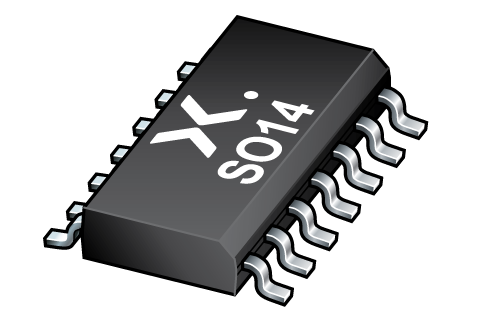Orderable parts
| Type number | Orderable part number | Ordering code (12NC) | Package | Buy from distributors |
|---|---|---|---|---|
| 74AHC74D | 74AHC74D,118 | 935263078118 | SOT108-1 | Order product |
Discover Nexperia’s extensive portfolio of diodes, bipolar transistors, ESD protection devices, MOSFETs, GaN FETs, IGBTs, and analog & logic ICs. Our components power virtually every electronic design worldwide - from automotive and industrial to mobile and consumer applications.
Our products find applications across various industries, from automotive and industrial to power, computing, consumer, mobile, and wearables. With a commitment to innovation and sustainability, our components set benchmarks in efficiency, empowering our global customer base to develop energy-efficient and cutting-edge solutions.
Try out our devices and their performance with our comprehensive range of evaluation boards. Gain a deeper understanding of how our products can benefit your application, whether it's optimizing for efficiency, robustness, or reliability. You can find Application focus, Package focus, and different Nexperia Product focus boards here.

Register once, drag and drop ECAD models into your CAD tool and speed up your design.
Click here for more informationDual D-type flip-flop with set and reset; positive-edge trigger
The 74AHC74; 74AHCT74 is a high-speed Si-gate CMOS device and is pin compatible with Low-Power Schottky TTL (LSTTL). It is specified in compliance with JEDEC standard No. 7-A.
The 74AHC74; 74AHCT74 is a dual positive-edge triggered, D-type flip-flop with individual data inputs (D), clock inputs (CP), set inputs (SD) and reset inputs (RD). It also has complementary outputs (Q and Q).
The set and reset are asynchronous active LOW inputs that operate independent of the clock input. Information on the data input is transferred to the Q output on the LOW to HIGH transition of the clock pulse. The data inputs must be stable one set-up time prior to the LOW to HIGH clock transition for predictable operation.
Schmitt-trigger action in the clock input makes the circuit highly tolerant to slower clock rise and fall times.
Balanced propagation delays
All inputs have Schmitt-trigger actions
Inputs accept voltages higher than VCC
Input levels:
For 74AHC74: CMOS level
For 74AHCT74: TTL level
ESD protection:
HBM: ANSI/ESDA/JEDEC JS-001 class 2 exceeds 2000 V
CDM: ANSI/ESDA/JEDEC JS-002 class C3 exceeds 1000 V
Multiple package options
Specified from -40 °C to +85 °C and from -40 °C to +125 °C
| Type number | VCC (V) | Logic switching levels | Output drive capability (mA) | tpd (ns) | fmax (MHz) | Power dissipation considerations | Tamb (°C) | Rth(j-a) (K/W) | Ψth(j-top) (K/W) | Rth(j-c) (K/W) | Package name |
|---|---|---|---|---|---|---|---|---|---|---|---|
| 74AHC74D | 2.0 - 5.5 | CMOS | ± 8 | 3.7 | 170 | low | -40~125 | 108 | 20.1 | 66 | SO14 |
| Model Name | Description |
|---|---|
|
|
| Type number | Orderable part number, (Ordering code (12NC)) | Status | Marking | Package | Package information | Reflow-/Wave soldering | Packing |
|---|---|---|---|---|---|---|---|
| 74AHC74D | 74AHC74D,118 (935263078118) |
Active | 74AHC74D |

SO14 (SOT108-1) |
SOT108-1 |
SO-SOJ-REFLOW
SO-SOJ-WAVE WAVE_BG-BD-1 |
SOT108-1_118 |
| Type number | Orderable part number | Chemical content | RoHS | RHF-indicator |
|---|---|---|---|---|
| 74AHC74D | 74AHC74D,118 | 74AHC74D |
|
|
| File name | Title | Type | Date |
|---|---|---|---|
| 74AHC_AHCT74 | Dual D-type flip-flop with set and reset; positive-edge trigger | Data sheet | 2025-04-29 |
| AN11106 | Pin FMEA for AHC/AHCT family | Application note | 2019-01-09 |
| AN90063 | Questions about package outline drawings | Application note | 2025-06-13 |
| SOT108-1 | 3D model for products with SOT108-1 package | Design support | 2020-01-22 |
| ahc74 | ahc74 IBIS model | IBIS model | 2013-04-08 |
| Nexperia_package_poster | Nexperia package poster | Leaflet | 2020-05-15 |
| SO14_SOT108-1_mk | plastic, small outline package; 14 leads; 1.27 mm pitch; 8.65 mm x 3.9 mm x 1.75 mm body | Marcom graphics | 2017-01-28 |
| SOT108-1 | plastic, small outline package; 14 leads; 1.27 mm pitch; 8.65 mm x 3.9 mm x 1.75 mm body | Package information | 2023-11-07 |
| SOT108-1_118 | SO14; Reel pack for SMD, 13"; Q1/T1 product orientation | Packing information | 2024-02-19 |
| 74AHC74D_Nexperia_Product_Reliability | 74AHC74D Nexperia Product Reliability | Quality document | 2025-03-20 |
| SO-SOJ-REFLOW | Footprint for reflow soldering | Reflow soldering | 2009-10-08 |
| SO-SOJ-WAVE | Footprint for wave soldering | Wave soldering | 2009-10-08 |
| WAVE_BG-BD-1 | Wave soldering profile | Wave soldering | 2021-09-08 |
If you are in need of design/technical support, let us know and fill in the answer form we'll get back to you shortly.
The Nexperia Longevity Program is aimed to provide our customers information from time to time about the expected time that our products can be ordered. The NLP is reviewed and updated regularly by our Executive Management Team. View our longevity program here.
| Model Name | Description |
|---|---|
|
|
| Type number | Orderable part number | Ordering code (12NC) | Status | Packing | Packing Quantity | Buy online |
|---|---|---|---|---|---|---|
| 74AHC74D | 74AHC74D,118 | 935263078118 | Active | SOT108-1_118 | 2,500 |
|
As a Nexperia customer you can order samples via our sales organization.
If you do not have a direct account with Nexperia our network of global and regional distributors is available and equipped to support you with Nexperia samples. Check out the list of official distributors.
The interactive datasheets are based on the Nexperia MOSFET precision electrothermal models. With our interactive datasheets you can simply specify your own conditions interactively. Start by changing the values of the conditions. You can do this by using the sliders in the condition fields. By dragging the sliders you will see how the MOSFET will perform at the new conditions set.